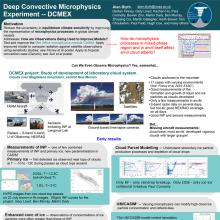The Deep Convective Microphysics EXperiment (DCMEX)
Alan
Blyth
National Centre for Atmospheric Science, University of Leeds
Poster
The Deep Convective Microphysics EXperiment (DCMEX) has an overall goal of reducing the uncertainty in cloud feedbacks associated with deep convection by improving the representation of microphysical processes in the UK Met Office UM/CASIM model. There is a focus in DCMEX on anvil radiative properties.
A field campaign was held in and around the convective clouds that grew steadily over the Magdalena Mountains, New Mexico from 19 July to 8 August, 2022. The aim was to make observations of aerosols, ice nucleating particles (INPs), and the microphysics and dynamics of the clouds to make new discoveries and provide novel measurements to improve the representation of microphysics processes in CASIM. The next stage of the project is to use the improved model for tropical deep convection
cases. The final stage is to use knowledge from the field campaign and modelling to improve the representation of cloud physics in GCMs.
Measurements were made in the field campaign with the FAAM aircraft, ground-based aerosol instruments and cameras, two radars, and with the NEXRAD radars and GOES-17 satellite instruments. There were 18 cases with a variety of values of relative humidity at 850 mb, vertical wind shear, cloud base heights, and CAPE. The aircraft sampling strategy was to measure the aerosols, including INP around the mountain, to ascend with the growing cloud tops and also to make passes at various
levels in the clouds including in and around temperatures of -5 to -10C and at lower temperatures. This talk will present a summary of the project and the early results, including: There is evidence of primary ice particles in concentrations within the range of INP measurements; there were observations of secondary ice particles (SIPs) near -5C in many cases, but not all; and there is some suggestion of SIPs being detected at lower temperatures.
A field campaign was held in and around the convective clouds that grew steadily over the Magdalena Mountains, New Mexico from 19 July to 8 August, 2022. The aim was to make observations of aerosols, ice nucleating particles (INPs), and the microphysics and dynamics of the clouds to make new discoveries and provide novel measurements to improve the representation of microphysics processes in CASIM. The next stage of the project is to use the improved model for tropical deep convection
cases. The final stage is to use knowledge from the field campaign and modelling to improve the representation of cloud physics in GCMs.
Measurements were made in the field campaign with the FAAM aircraft, ground-based aerosol instruments and cameras, two radars, and with the NEXRAD radars and GOES-17 satellite instruments. There were 18 cases with a variety of values of relative humidity at 850 mb, vertical wind shear, cloud base heights, and CAPE. The aircraft sampling strategy was to measure the aerosols, including INP around the mountain, to ascend with the growing cloud tops and also to make passes at various
levels in the clouds including in and around temperatures of -5 to -10C and at lower temperatures. This talk will present a summary of the project and the early results, including: There is evidence of primary ice particles in concentrations within the range of INP measurements; there were observations of secondary ice particles (SIPs) near -5C in many cases, but not all; and there is some suggestion of SIPs being detected at lower temperatures.

Blyth-Alan-poster.pdf
(8.97 MB)
Meeting homepage
